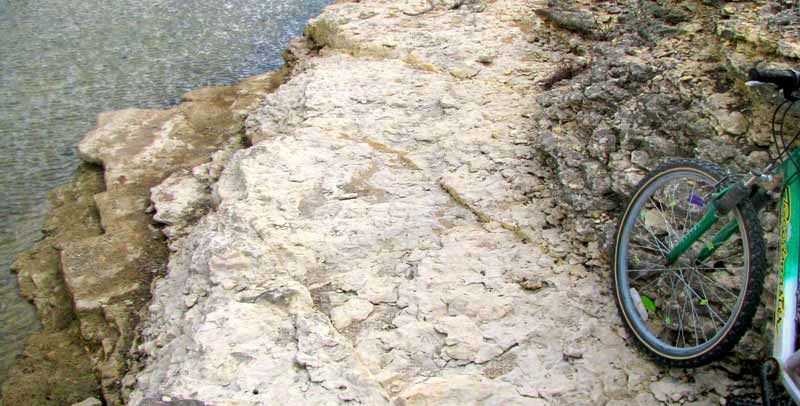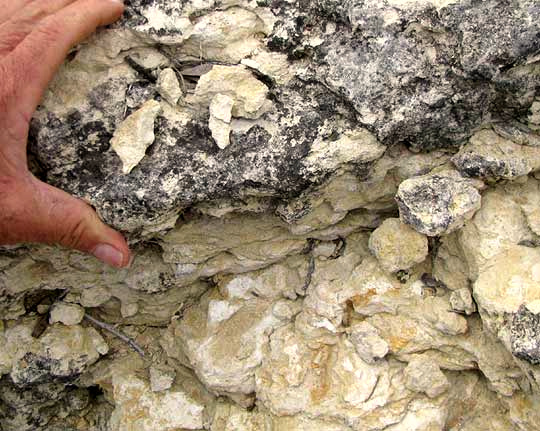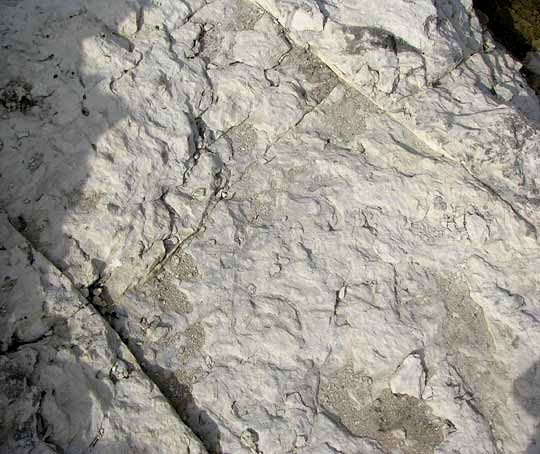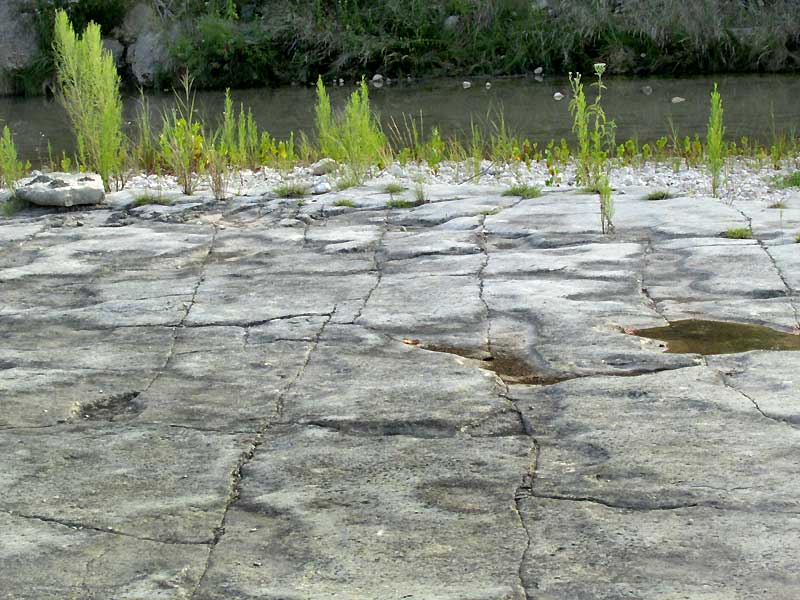Excerpts from Jim Conrad's
Naturalist Newsletter

from the February 10, 2013 Newsletter issued from the valley of the Dry Frio River in northern Uvalde County, southwestern Texas, on the southern border of the Edwards Plateau; elevation ~1750m (~5750 ft); N29.62°, W99.86°; USA
MUDROCK
A nice place to visit along the little Dry Frio River flowing behind the cabin is a spot where the water comes right up to a flattish bed of rocks running alongside the stream just above water level. Here you can sit or lie in the sun without insects in the grass bothering you. Above you can see the spot, with the bicycle I use providing scale.
The brown, more smoothly surfaced rock closest to the water is shale. The whitish rock layer above the shale and on which the bicycle tires rest looks like a layer of lumpy mud -- except that it's rock hard and sandwiched between other layers of bedrock we know to be of early Cretaceous age. This mud was deposited about 100,000,000 years ago, back when dinosaurs roamed the Earth. In fact, a bit east of here, in northeastern Uvalde County near Utopia, paleontologists have documented dinosaur tracks in similar stone.
The whitish rock the bicycle stands on can be called mudrock. It was deposited as mud but over millions of years it transformed, or "lithified," into rock.
But, the term mudrock is very general and imprecise. According to some estimations, over half of all sedimentary rocks can be called mudrock. Mudrocks are those composed of fine-grained (smaller than sand), silicon-based particles that have broken off other rocks and which were transported and deposited as mud. Such rocks are said to be "siliciclastic," the "silici" referring to silicon -- and over 90% of the Earth's crust is composed of silicate minerals -- and the "clastic" referring to rocks composed of fragments, or "clasts," of pre-existing minerals and rocks.
With technical analysis, mudrocks can be assigned more precise names, such as claystone, mudstone (as opposed to mudrock), siltstone, shale and slate. The categories are defined in terms of the size of the particles of which the mudrock is composed, and the manner in which the rock's structure has altered during the lithification process. A problem with these sub-categories of mudrock is that the experts aren't in agreement on a standard set of criteria, and a standard terminology.
Basically, if you have a sedimentary rock composed of tiny particles smaller than sand, and the source material for the rock was a silicon-based rock or mineral (not a carbonate like limestone), you can pretty safely call it a mudrock. And mudrocks have many appearances. Above we saw mudrock forming flat, even beds. Right above the bicycle the mudrock assumes a different face, becoming much more irregular and heterogonous in content, as shown in the lower half of the picture below:

In that picture, possibly the darker rock above the white mudrock also is mudrock, or maybe it's "lime mudstone"... Fact is, lots of rocks can't be clearly and neatly assigned any specific name everyone would agree on. It's only in human heads where everything must fit into this or that conceptual pigeonhole. Nature doesn't feel at all obliged to limit its creations to humankind's artificial mental categories.
from the February 10, 2013 Newsletter issued from the valley of the Dry Frio River in northern Uvalde County, southwestern Texas, on the southern border of the Edwards Plateau; elevation ~1750m (~5750 ft); N29.62°, W99.86°; USA
JOINTS IN MUDROCK
In the above picture of the bicycle on the flattish mudrock you may have noticed a straight fracture in the mudrock originating in front of the bicycle and running across the rock in the same direction as the tire. A close-up of the rock break with others beside it, forming a big H occupying most of the picture, is shown below:

These breaks in the rock are not faults, but rather joints, and joints are very commonly seen in a wide variety of rocks and in many geological environments. The difference between a fault and a joint is that faults are fractures where one side of the break slides past the other. Joints are breaks in the rock where little or no "lateral displacement" -- sides sliding past one another -- has taken place.
Joints form in rocks for various reasons. Forces from within the Earth that shift continents around and cause land masses to rise and sink -- tectonic forces -- can warp layers of rock causing them to crack into joints. When hot rocks cool, as when lava from a volcano cools, joints can form as the cooling rocks contract. The most common cause of joints, however, is when erosion removes overlying rocks, thus reducing the weight bearing down on a stratum. This loss of pressure cases the stratum to need to expand, but it's can't, so it buckles and fractures with many joints.
Joints often run predominantly one way or another, depending on the location of the pressures and release points causing the fractures. These alignments are so regular and predictable that sometimes the geologically savvy can use joints as natural compasses plainly visible in the landscape.
Issued August 28, 2020 from the valley of the Dry Frio River in northern Uvalde County, southwestern Texas, on the southern border of the Edwards Plateau; elevation ~1750m (~5750 ft); N29.62°, W99.86°; USA
MORE JOINTS IN MUDROCK
The joints appearing below are especially well formed. They're a few feet from where the Dry Frio crosses from Real County into Uvalde County the Glen Rose Formation:
